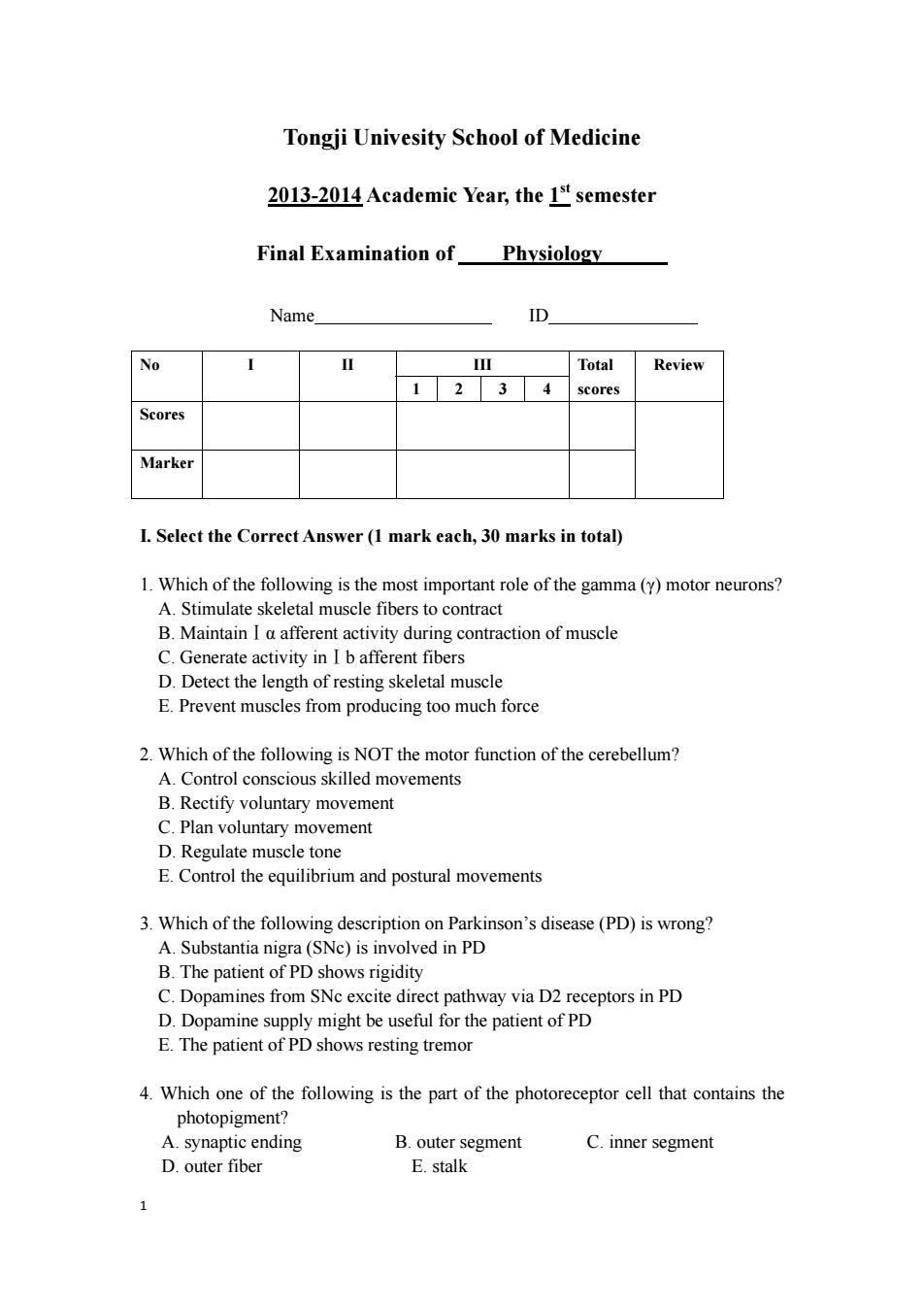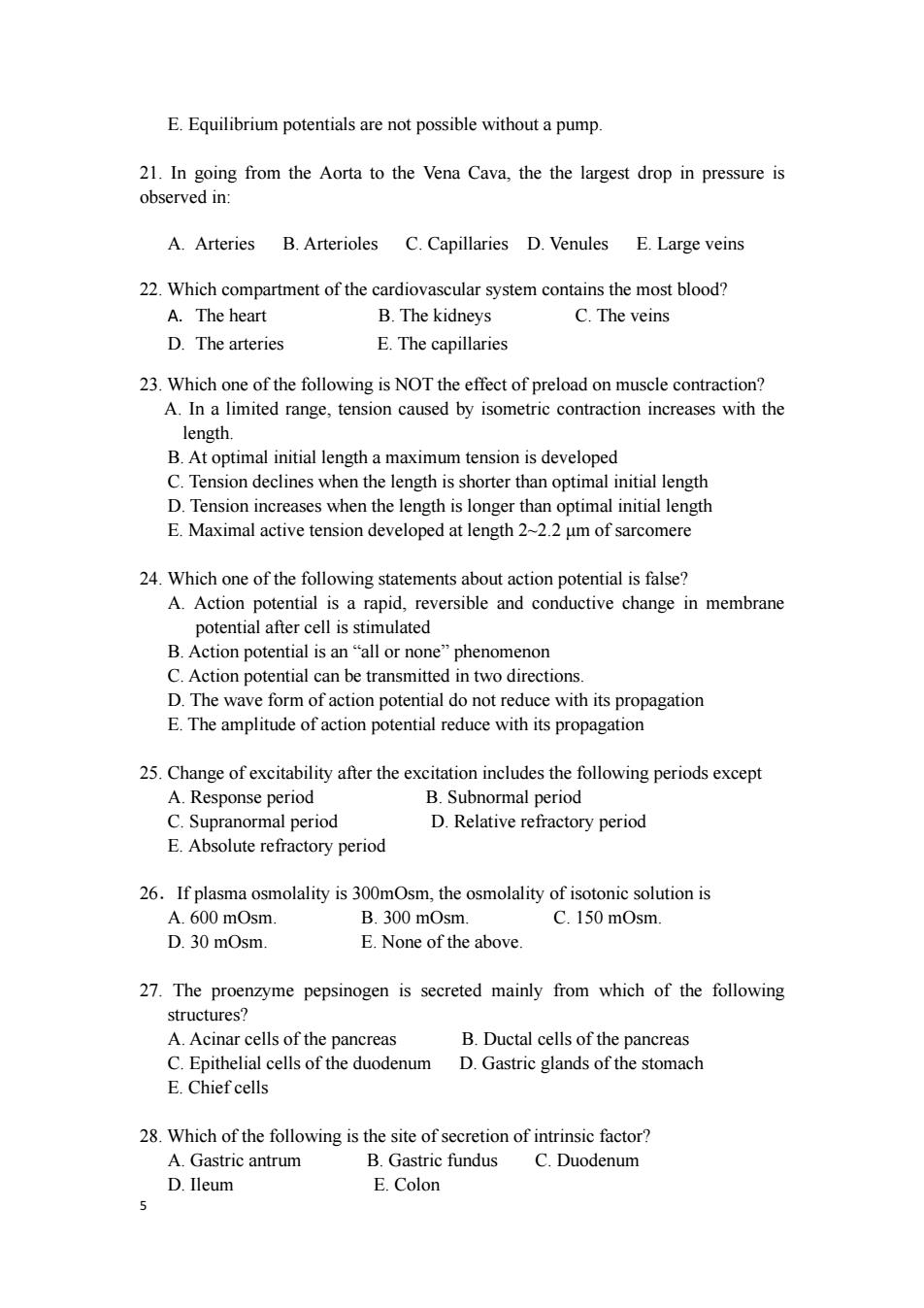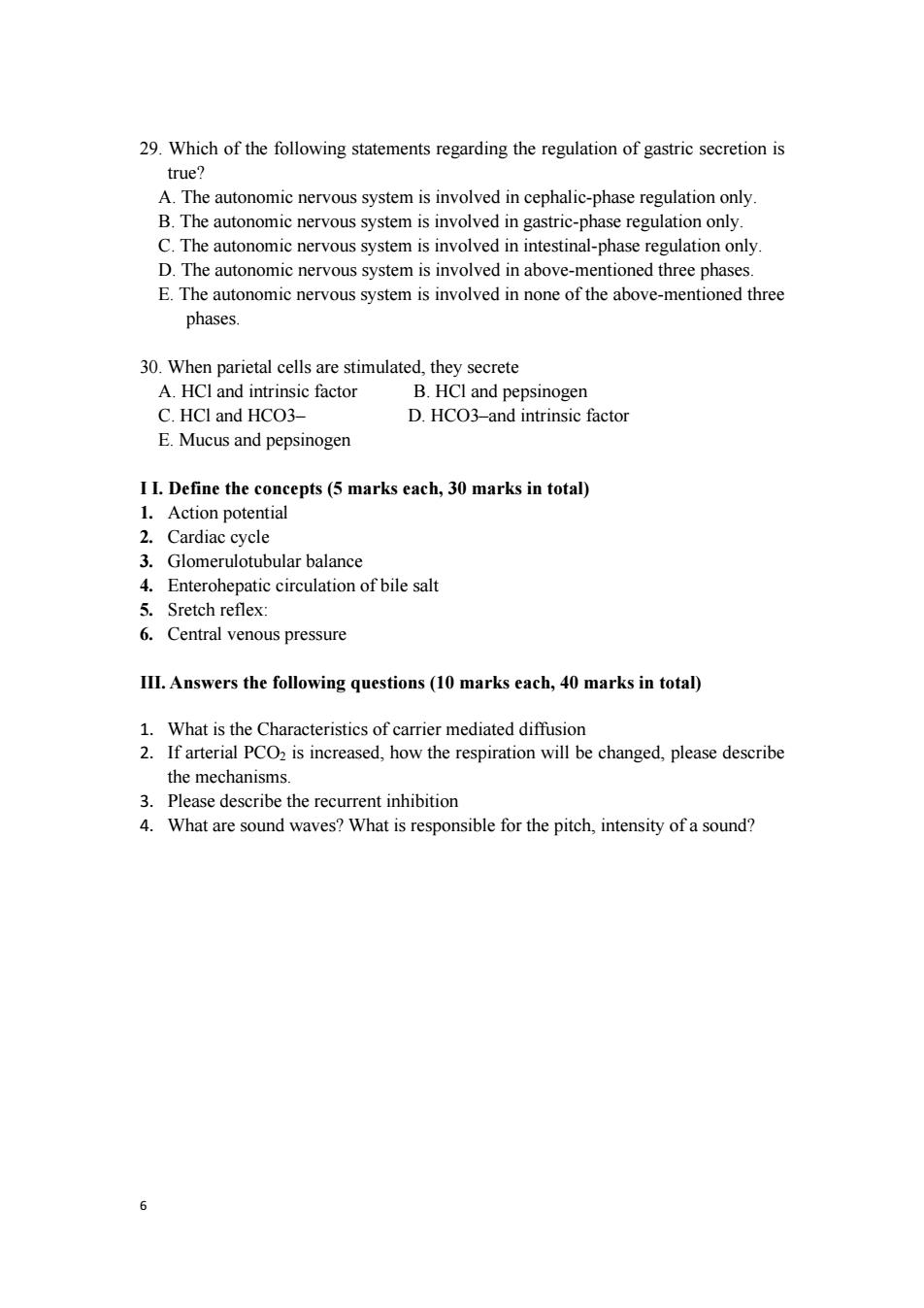
Tongji Univesity School of Medicine 2013-2014 Academic Year,the 1s semester Final Examination of Physiology Name D No Total Review 1 2 3 4 scores Scores Marker I.Select the Correct Answer(1 mark each,30 marks in total) 1.Which of the following is the most important role of the gamma ()motor neurons? A.Stimulate skeletal muscle fibers to contract B.Maintain I a afferent activity during contraction of muscle C.Generate activity in I b afferent fibers D.Detect the length of resting skeletal muscle E.Prevent muscles from producing too much force 2.Which of the following is NOT the motor function of the cerebellum? A.Control conscious skilled movements B.Rectify voluntary movement C.Plar oluntary movement D.Regulate muscle tone E.Control the equilibrium and postural movements 3.Which of the following description on Parkinson's disease(PD)is wrong? A.Substantia nigra(SNc)is involved in PD B.The patient of PD shows rigidity C.Dopamines from SNc excite direct pathway via D2 receptors in PD D.Dopamine supply might be useful for the patient of PD E.The patient of PD shows resting tremor 4.Which one of the following is the part of the photoreceptor cell that contains the photopigment A.synaptic ending B.outer segment C.inner segment D.outer fiber E.stalk 1
1 Tongji Univesity School of Medicine 2013-2014 Academic Year, the 1st semester Final Examination of ____Physiology______ Name ID No I II III 1 2 3 4 Total scores Review Scores Marker I. Select the Correct Answer (1 mark each, 30 marks in total) 1. Which of the following is the most important role of the gamma (γ) motor neurons? A. Stimulate skeletal muscle fibers to contract B. MaintainⅠα afferent activity during contraction of muscle C. Generate activity inⅠb afferent fibers D. Detect the length of resting skeletal muscle E. Prevent muscles from producing too much force 2. Which of the following is NOT the motor function of the cerebellum? A. Control conscious skilled movements B. Rectify voluntary movement C. Plan voluntary movement D. Regulate muscle tone E. Control the equilibrium and postural movements 3. Which of the following description on Parkinson’s disease (PD) is wrong? A. Substantia nigra (SNc) is involved in PD B. The patient of PD shows rigidity C. Dopamines from SNc excite direct pathway via D2 receptors in PD D. Dopamine supply might be useful for the patient of PD E. The patient of PD shows resting tremor 4. Which one of the following is the part of the photoreceptor cell that contains the photopigment? A. synaptic ending B. outer segment C. inner segment D. outer fiber E. stalk

which one of the following fluids fills the membranous labyrinth including the A.water B.perilymph C.serum D.plasma E.endolymph 6.Which of the following is NOT the characteristic of fast pain? A.Occurs rapidly after stimuli(1 second) C.Not felt in deeper tissues D.Needs larger A nerve fibers E.Felt in both superficial and deeper tissues 7.Lung Volumes A.Tidal Volume at rest is larger than Inspiratory Reserve Volume. B.Tidal Volume is the volume of air expired during each breath c.Reserve volume is the volume of air in the lungs after a normal expiration D.Vital Capacity isequal to the Tidal Volume and the Inspiratory Reserve Volume. E.All lung volumes can be measured with a Spirometer 8.Mechanics of breathing A.The elasticity of the lungs helps to expand the alveoli. B.At the end of expiration,the alveolar pressure is greater than atmospheric pressure. C.At the end of inspiration,the atmospheric pressure is equal to the alveolar pressure. D.The intrapleural pressure is positive during a normal expiration. E.Trans-pulmonary pressure is the value of atmospheric pressure minus the alveolar pressure. 9.Lung Properties A.Lung Compliance is proportionate to Lung Elasticity B.Lung Recoil is inversely related to Alveolar Surface Tension Force. C.Pulmonary Surfactant reduces the Lung Recoil Force D.Boyle's Law explains the essential effect of pulmonary surfactant at the alveoli E.The anatomical dead space includes some of normal alveolar space 10.Carbon Dioxide Transport A.About 50%of CO2 is transported in the form of carbamino-hemoglobin. 2
2 5. Which one of the following fluids fills the membranous labyrinth including the cochlear duct? A. water B. perilymph C. serum D. plasma E. endolymph 6. Which of the following is NOT the characteristic of fast pain? A. Occurs rapidly after stimuli (1 second) B. Sharp pain like needle puncture or cut C. Not felt in deeper tissues D. Needs larger A nerve fibers E. Felt in both superficial and deeper tissues 7. Lung Volumes A. Tidal Volume at rest is larger than Inspiratory Reserve Volume. B. Tidal Volume is the volume of air expired during each breath. C. Reserve Volume is the volume of air in the lungs after a normal expiration. D. Vital Capacity is equal to the Tidal Volume and the Inspiratory Reserve Volume. E. All lung volumes can be measured with a Spirometer. 8. Mechanics of breathing A. The elasticity of the lungs helps to expand the alveoli. B. At the end of expiration, the alveolar pressure is greater than atmospheric pressure. C. At the end of inspiration, the atmospheric pressure is equal to the alveolar pressure. D. The intrapleural pressure is positive during a normal expiration. E. Trans-pulmonary pressure is the value of atmospheric pressure minus the alveolar pressure. 9. Lung Properties A. Lung Compliance is proportionate to Lung Elasticity B. Lung Recoil is inversely related to Alveolar Surface Tension Force. C. Pulmonary Surfactant reduces the Lung Recoil Force D. Boyle’s Law explains the essential effect of pulmonary surfactant at the alveoli. E. The anatomical dead space includes some of normal alveolar space. 10. Carbon Dioxide Transport A. About 50 % of CO2 is transported in the form of carbamino -hemoglobin

B.Most of the bicarbonate in venous blood is formed from CO2 reacting with water in the plasma. C.When hemoglobin buffers hydrogen ions,it helps to generate more bicarbonate ions inside the red blood cells. D.Bohr's effect explains how the partial pressure ofoxygen affects the transpor of CO2 E.The partial pressure of CO2 in venous blood is 40 mmHg 11.Control of breathing A.The frequency of breathing is determined by the number of action potential generated during inspiration and expiration. B.During voluntary hyperventilation,the respiratory center neurons in the brainstem generate more action potentials. C.During mountain climbing.ventilation is stimulated by higher CO2 in the blood D.In lactic acidosis,the central chemoreceptors are stimulated E.In heart failure,the carotid bodies can be stimulated by lack of oxygen supply. 12.Functional Structure of Nephron A.The juxta-medullary nephrons are about 25%of the total nephron populations B.The Peritubular capillary is involved in filtration C.The macula densa is part of the afferent arteriole D.The glomerulus is permeable to both glucose and sodium E.The Vasa Recta is a smooth muscle structure. 13.Glomerular Filtration A.The normal filtration rate is 120 liters per day B.There are two glomerular forces that promote filtration. C.The glomerular hydrostatic pressure is about 25 mmHg D.The glomerular oncotic pressure is due to plasma protein concentration. E.Filtration process requires ATPase 14.Renin Angiotensin System(RAS) A.Renin is secreted by the macula densa of the juxta-glomerular apparatus. B.In negative sodium balance.plasma renin level will be high. C.Increased renal perfusion pressure will stimulate renin secretion D.Angiotensin II is produced by the adrenal cortex 3
3 B. Most of the bicarbonate in venous blood is formed from CO2 reacting with water in the plasma. C. When hemoglobin buffers hydrogen ions, it helps to generate more bicarbonate ions inside the red blood cells. D. Bohr’s effect explains how the partial pressure of oxygen affects the transport of CO2. E. The partial pressure of CO2 in venous blood is 40 mmHg. 11. Control of breathing A. The frequency of breathing is determined by the number of action potentials generated during inspiration and expiration. B. During voluntary hyperventilation, the respiratory center neurons in the brainstem generate more action potentials. C. During mountain climbing, ventilation is stimulated by higher CO2 in the blood. D. In lactic acidosis, the central chemoreceptors are stimulated. E. In heart failure, the carotid bodies can be stimulated by lack of oxygen supply. 12. Functional Structure of Nephron A. The juxta-medullary nephrons are about 25 % of the total nephron populations. B. The Peritubular capillary is involved in filtration. C. The macula densa is part of the afferent arteriole. D. The glomerulus is permeable to both glucose and sodium. E. The Vasa Recta is a smooth muscle structure. 13. Glomerular Filtration A. The normal filtration rate is 120 liters per day. B. There are two glomerular forces that promote filtration. C. The glomerular hydrostatic pressure is about 25 mmHg. D. The glomerular oncotic pressure is due to plasma protein concentration. E. Filtration process requires ATPase. 14. Renin Angiotensin System (RAS) A. Renin is secreted by the macula densa of the juxta-glomerular apparatus. B. In negative sodium balance, plasma renin level will be high. C. Increased renal perfusion pressure will stimulate renin secretion D. Angiotensin II is produced by the adrenal cortex

E.Angiotensin II is a dipsogenic and a vasodilator 15.Renal Autoregulation a.This mechanism maintains renal perfusion pressure B.This mechanism requires renal sympathetic nerve activity C.This mechanism needs circulating angiotensin II. D.This mechanism controls both renal blood flow and glomerular filtration E.This mechanism increases the secretion of renin 16.Kidney Functions A.In kidney failure,the pH of blood will increase B.The kidneys secrete less erythropoietin during hypoxia. C.Osmoreceptors involved in water balance are found in the kidneys. D.Sodium sensors involved in sodium balance are only located in the kidneys. E.Both receptors for aldosterone and vasopressin are located at the collecting ducts 17.Colloid osmotic pressure refers to osmotic pressure exerted by A.Ions. B.Uncharged molecules C.Lipid soluble compounds. D.Proteins. E.All of the solutes in plasma,acting together. 18.Hexose is moving into a cell and no cellular energy is being directly or indirectly expended in the process.The hexose is entering by A.Diffusing directly through the lipid bilaver. B.Facilitated diffusion on a protein carrier molecule. C.A Na-hexose cotransporter. D A Na-he E.A Na-hexose ATPase 19.Oxygen molecules,moving by diffusion,will equilibrate most rapidly across which of the following structures? A.A capillary wall. B.a fenestrated capillary C A la of skin cells D.A ventricular wall. E.A lipid bilayer 20.Acell needs to have a Na-K ATPase pump because A.The pump creates the membrane potential. B The n ump is responsiblefor the production of action potentials C.Without a pump,ion fluxes through channels will accumulate and alter concentrations of ions. D.The pump moves water out of the cell,preventing cell death by osmosis
4 E. Angiotensin II is a dipsogenic and a vasodilator. 15. Renal Autoregulation A. This mechanism maintains renal perfusion pressure. B. This mechanism requires renal sympathetic nerve activity. C. This mechanism needs circulating angiotensin II. D. This mechanism controls both renal blood flow and glomerular filtration. E. This mechanism increases the secretion of renin. 16. Kidney Functions A. In kidney failure, the pH of blood will increase. B. The kidneys secrete less erythropoietin during hypoxia. C. Osmoreceptors involved in water balance are found in the kidneys. D. Sodium sensors involved in sodium balance are only located in the kidneys. E. Both receptors for aldosterone and vasopressin are located at the collecting ducts. 17. Colloid osmotic pressure refers to osmotic pressure exerted by A. Ions. B. Uncharged molecules. C. Lipid soluble compounds. D. Proteins. E. All of the solutes in plasma, acting together. 18. Hexose is moving into a cell and no cellular energy is being directly or indirectly expended in the process. The hexose is entering by A. Diffusing directly through the lipid bilayer. B. Facilitated diffusion on a protein carrier molecule. C. A Na-hexose cotransporter. D. A Na-hexose antiporter. E. A Na-hexose ATPase. 19. Oxygen molecules, moving by diffusion, will equilibrate most rapidly across which of the following structures? A. A capillary wall. B. A fenestrated capillary. C. A layer of skin cells. D. A ventricular wall. E. A lipid bilayer. 20. A cell needs to have a Na-K ATPase pump because A. The pump creates the membrane potential. B. The pump is responsible for the production of action potentials. C. Without a pump, ion fluxes through channels will accumulate and alter concentrations of ions. D. The pump moves water out of the cell, preventing cell death by osmosis

E.Equilibrium potentials are not possible without a pump. 21.In going from the Aorta to the Vena Cava,the the largest drop in pressure is observed in: A.Arteries B.Arterioles C.Capillaries D.Venules E.Large veins 22.Which compartment of the cardiovascular system contains the most blood? A.The heart B.The kidneys C.The veins D.The arteries E.The capillaries 23.Which one of the following is NOT the effect of preload on muscle contraction? A.In a limited range,tension caused by isometric contraction increases with the length. B.At optimal initial length a maximum tension is developed C.Tension declines when the length is shorter than optimal initial length D.than optimal initiale E.Maximal active tension developed at length 2-2.2 m of sarcomere 24.Which one of the following statements about action potential is false? A.Action potential is a rapid,reversible and conductive change in membrane potential after cell is B.Action potential is an"all or none"phenomenon C.Action potential can be transmitted in two directions. D.The wave form of action potential do not reduce with its propagation E.The amplitude of action potential reduce with its propagation 25.Change of excitability after the excitation includes the following periods except A.Response period B.Subnormal period C.Supranormal period D.Relative refractory period E.Absolute refractory period 26.If plasm osmolality is 300mOsm,the osmolality of iso tonic solution is A.600 mOsm B.300 mOsm. 150 mOsm D.30 mOsm. E.None of the above 27.The proenzyme pepsinogen is secreted mainly from which of the following es? A.Acinar cells of the pancreas B.Ductal cells of the pancreas C.Epithelial cells of the duodenum D.Gastric glands of the stomach E.Chief cells 28.Which of the following is the site of secretion of intrinsic factor? A.Gastric antrum B G C.Duodenum D.Ileum E.Colon 5
5 E. Equilibrium potentials are not possible without a pump. 21. In going from the Aorta to the Vena Cava, the the largest drop in pressure is observed in: A. Arteries B. Arterioles C. Capillaries D. Venules E. Large veins 22. Which compartment of the cardiovascular system contains the most blood? A. The heart B. The kidneys C. The veins D. The arteries E. The capillaries 23. Which one of the following is NOT the effect of preload on muscle contraction? A. In a limited range, tension caused by isometric contraction increases with the length. B. At optimal initial length a maximum tension is developed C. Tension declines when the length is shorter than optimal initial length D. Tension increases when the length is longer than optimal initial length E. Maximal active tension developed at length 2~2.2 µm of sarcomere 24. Which one of the following statements about action potential is false? A. Action potential is a rapid, reversible and conductive change in membrane potential after cell is stimulated B. Action potential is an “all or none” phenomenon C. Action potential can be transmitted in two directions. D. The wave form of action potential do not reduce with its propagation E. The amplitude of action potential reduce with its propagation 25. Change of excitability after the excitation includes the following periods except A. Response period B. Subnormal period C. Supranormal period D. Relative refractory period E. Absolute refractory period 26.If plasma osmolality is 300mOsm, the osmolality of isotonic solution is A. 600 mOsm. B. 300 mOsm. C. 150 mOsm. D. 30 mOsm. E. None of the above. 27. The proenzyme pepsinogen is secreted mainly from which of the following structures? A. Acinar cells of the pancreas B. Ductal cells of the pancreas C. Epithelial cells of the duodenum D. Gastric glands of the stomach E. Chief cells 28. Which of the following is the site of secretion of intrinsic factor? A. Gastric antrum B. Gastric fundus C. Duodenum D. Ileum E. Colon

29.Which of the following statements regarding the regulation of gastric secretion is true? A.The autonomic nervous system is involved in cephalic-phase regulation only. B.The autonomic nervous system is involved in gastric-phase regulation only. C.The autonomic nervous system is involved in intestinal-phase regulation only D.The autonomic nervous system is involved in above-mentioned three phases E.The autonomic nervous system is involved in none of the above-mentioned three phases. 30.When parietal cells are stimulated,they secrete A.HCI and intrinsic factor C.HCI and HCO3 E.Mucus and pepsinogen I I.Define the concepts(5 marks each,30 marks in total) 1.Action potential Glomerulotubular balance Enterohepatic circulation of bile salt 5.Sretch reflex: 6.Central venous pressure II.Answers the following questions(10 marks each,40 marks in total) 1.What is the Characteristics of carrier mediated diffusion 2.If arterial PCO,is increased,how the respiration will be changed,please describe the mechanisms. 3.Please describe the recurrent inhibition 4.What are sound v waves What is responsible for the pitch,intensity of a sound? 6
6 29. Which of the following statements regarding the regulation of gastric secretion is true? A. The autonomic nervous system is involved in cephalic-phase regulation only. B. The autonomic nervous system is involved in gastric-phase regulation only. C. The autonomic nervous system is involved in intestinal-phase regulation only. D. The autonomic nervous system is involved in above-mentioned three phases. E. The autonomic nervous system is involved in none of the above-mentioned three phases. 30. When parietal cells are stimulated, they secrete A. HCl and intrinsic factor B. HCl and pepsinogen C. HCl and HCO3– D. HCO3–and intrinsic factor E. Mucus and pepsinogen I I. Define the concepts (5 marks each, 30 marks in total) 1. Action potential 2. Cardiac cycle 3. Glomerulotubular balance 4. Enterohepatic circulation of bile salt 5. Sretch reflex: 6. Central venous pressure III. Answers the following questions (10 marks each, 40 marks in total) 1. What is the Characteristics of carrier mediated diffusion 2. If arterial PCO2 is increased, how the respiration will be changed, please describe the mechanisms. 3. Please describe the recurrent inhibition 4. What are sound waves? What is responsible for the pitch, intensity of a sound?